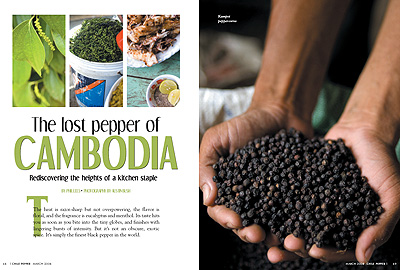Ten miles out of town, my guide pulls up at a little shack on a winding roadside. This is real boondocks Cambodia. Little kids are staring at me like they’ve never seen a white man before, which they probably haven’t.
From “Man bites frog”
I miss the days when I used to rant about the Cambodian spider story of the week, where a Western journalist, parachuted into a strange land, proceeds to take the local food completely out of context. It gave me a regular windmill to tilt at. Now when I pitch articles about the possibility of Cambodian food being a varied and delicate cuisine to magazines, I’m sure that the grim thought lurking in the back of every editor’s mind is “They eat spiders, don’t they”. Sean Thomas’ recent article in The Independent is a tour-de-force of the culinary racism that does me out of business.
What can you say about the decidedly unlovely tarantulas of Skuon? Except that they aren’t very lovely. Certainly, they are much prized in Cambodia – anyone who goes to Skuon is expected to bring back a bag of big roasted spiders for the kids. When told that these rancid, sugared arachnids are less than popular in the West, Cambodians are shocked and surprised. They find western cheese-eating equally repugnant, of course.
None of that is true apart from the spiders being manky. My Cambodian friends are cheese freaks. He finishes off by eating a dried frog in Phnom Penh, which is something that Cambodians don’t treat as food. Dried frog is for medicinal purposes and occasionally, a rice wine additive. Complaining about the way it tastes is a little like eating a few spoonfuls of straight cloves, then writing them off as useless as a foodstuff.
This is not to say that you can’t write about a food that you don’t know as a local: a perfect example of covering Cambodia well is Robyn and Dave from EatingAsia’s recent posts from Cambodia – they might not speak Khmer, but they can put the food into the context that they know well: similarities with Vietnamese and Isaan food; familiar herbs in an unfamiliar dish; photos that set the food in the real environment. It is a reminder that food is about tradition and memories, even if those traditions are not your own.
Props to Maytel for passing on the article.

